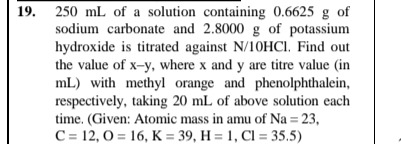Question
Question: 250 mL of a solution containing 0.6625 g of sodium carbonate and 2.8000 g of potassium hydroxide is ...
250 mL of a solution containing 0.6625 g of sodium carbonate and 2.8000 g of potassium hydroxide is titrated against N/10HCl. Find out the value of x-y, where x and y are titre value (in mL) with methyl orange and phenolphthalein, respectively, taking 20 mL of above solution each time. (Given: Atomic mass in amu of Na = 23, C = 12, O = 16, K = 39, H = 1, Cl = 35.5)

5
Solution
The solution contains sodium carbonate (Na2CO3) and potassium hydroxide (KOH). This is a mixture of a weak base and a strong base. We need to determine the titre values with phenolphthalein and methyl orange indicators.
1. Calculate Moles of Components in the 20 mL Aliquot:
-
Molar mass of Na2CO3: 2(23)+12+3(16)=46+12+48=106 g/mol
-
Molar mass of KOH: 39+16+1=56 g/mol
-
Moles of Na2CO3 in 250 mL solution: Moles=Molar MassMass=106 g/mol0.6625 g=0.00625 mol
-
Moles of KOH in 250 mL solution: Moles=Molar MassMass=56 g/mol2.8000 g=0.05 mol
-
Moles of Na2CO3 in 20 mL aliquot: Moles20 mL=0.00625 mol×250 mL20 mL=0.00625×0.08=0.0005 mol
-
Moles of KOH in 20 mL aliquot: Moles20 mL=0.05 mol×250 mL20 mL=0.05×0.08=0.004 mol
The titrant is N/10 HCl, which means its normality is 0.1 N.
2. Titration with Phenolphthalein Indicator (Titre value = y mL):
Phenolphthalein changes color when the solution pH is around 8.2-10. This indicates the completion of the following reactions:
- Strong base (KOH) reacts completely: KOH+HCl→KCl+H2O (1 mole KOH consumes 1 mole HCl, n-factor for KOH is 1)
- Weak base (Na2CO3) reacts partially to form bicarbonate: Na2CO3+HCl→NaHCO3+NaCl (1 mole Na2CO3 consumes 1 mole HCl, n-factor for Na2CO3 in this step is 1)
Total equivalents of HCl required for phenolphthalein endpoint: Equivalentsphenolphthalein=(Moles of KOH×1)+(Moles of Na2CO3×1) Equivalentsphenolphthalein=(0.004 mol×1)+(0.0005 mol×1) Equivalentsphenolphthalein=0.004+0.0005=0.0045 eq
Volume of HCl (y) = Normality of HClEquivalents=0.1 N0.0045 eq=0.045 L=45 mL So, y=45 mL.
3. Titration with Methyl Orange Indicator (Titre value = x mL):
Methyl orange changes color when the solution pH is around 3.1-4.4. This indicates the completion of the following reactions:
- Strong base (KOH) reacts completely: KOH+HCl→KCl+H2O (1 mole KOH consumes 1 mole HCl, n-factor for KOH is 1)
- Weak base (Na2CO3) reacts completely to form carbonic acid: Na2CO3+2HCl→H2CO3+2NaCl (1 mole Na2CO3 consumes 2 moles HCl, n-factor for Na2CO3 in this step is 2)
Total equivalents of HCl required for methyl orange endpoint: Equivalentsmethyl orange=(Moles of KOH×1)+(Moles of Na2CO3×2) Equivalentsmethyl orange=(0.004 mol×1)+(0.0005 mol×2) Equivalentsmethyl orange=0.004+0.001=0.0050 eq
Volume of HCl (x) = Normality of HClEquivalents=0.1 N0.0050 eq=0.050 L=50 mL So, x=50 mL.
4. Calculate x - y: x - y=50 mL−45 mL=5 mL
The value of x - y is 5 mL.
